Home » Products » Coating Inspection » Pinhole / Porosity Detection » Spark / Holiday Testers » Elcometer 266 DC High Voltage Holiday Detector
Elcometer 266 DC High Voltage Holiday Detector
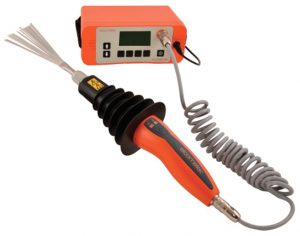
Product Description
The Elcometer 266 DC Holiday Detector revolutionises high voltage DC testing of coatings porosity detection making it safer, easier and more reliable than ever before.
The Elcometer 266 DC Holiday Detector can be used to test porosity on coatings up to 7.5mm thick and is ideal for inspecting coatings on pipelines and other protective coatings. This holiday tester features a built-in voltage calculator which will determine and set the correct test voltage based upon the test standard and the thickness of coating being tested.
Features of the Elcometer 266 DC Holiday Detector
• Voltage calculator automatically sets the correct voltage from your coating thickness value
• Adjustable Voltage
• Dual safety switch on handle
• Internal Voltmeter / Jeep tester
• Visual and audible alarms
• Interchangeable probe handles
• Universal probe adaptors
Elcometer 266 DC Holiday Detector Features Explained
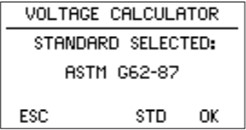 |
Voltage calculator Automatically sets the correct voltage from your coating thickness value. No need to use look up tables. Enter the test standard and the coating thickness and the gauge will automatically programme the correct voltage. |
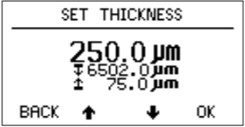 |
Adjustable Voltage No need for screwdriver: 0.5kV – 1kV in 50V steps, 1kV to 30kV in 100V steps. Sensitivity to current can be manually preset or automatically adjusted by the gauge for partially conductive coatings. |
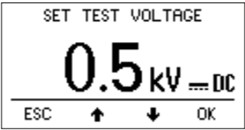 |
Internal Voltmeter / Jeep tester Ensures that the test voltage equals the selected voltage. The closed loop system ensures that the generated test voltage is accurately measured and continuously controlled, regardless of climatic conditions. |
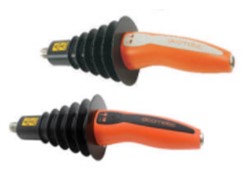 |
Interchangeable probe handles Available, 5kV, 15kV and 30kV DC and DC continuous versions. |
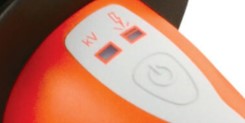 |
Audible and visual alarms Visual and audible alarms are activated when a flaw is detected. Bright LEDs on the handle, as well as a loud audible alarm, clearly indicate if the gauge is on (Red) and when a spark is detected (Blue).
|
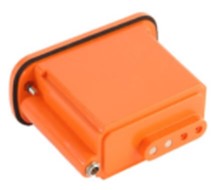 |
Battery pack Can be recharged inside or outside the gauge for continued use. Batteries are fully charged within 4 hours and provide up to 40 hours continuous use between charges. |
 |
Screen display Large, backlit display enables easy viewing even in dark environments. When a flaw is detected the backlight also flashes. |
 |
Second hand grip The optional second hand grip is designed for two handed use without compromising its safety. Ideal for testing pipes and tank floors. |
 |
Universal probe adaptors Enables the Elcometer 266 to work with all major holiday detector accessories. |
The Elcometer 266 DC Holiday Detector can be used in accordance with:
• ANSI/AWWA C213*
• AS 3894.1
• ASTM C 536
• ASTM C 537
• ASTM D 4787
• ASTM D 5162-B
• ASTM G 62-B
• BS1344-11
• DIN 55670
• EN 14430
• ISO 2746
• ISO 29601
• JIS K 6766
• NACE RP0274
• NACE RP0188*
• NACE RP0190*
• NACE RP0490*
• NACE SP0188
• NACE SP0490
* Standards not in bold have been superseded but are still recognised in some industries.
Specifications
Elcometer 266 DC High Voltage Holiday Detector – Specifications
| Part Number | Description | Certificate |
| D266—-4 | Elcometer 2661 | ο |
| High Voltage Output Accuracy | ±5% or ±50V below 1000 Volts | |
| Operating Temperature | 0°C to 50°C | |
| Power Supply | Rechargeable battery Pack; battery fully charged within 4 hours | |
Measured Current Flow Accuracy
|
±5% of full scale | |
| 0 – 100µA maximum Output Current | ||
| Typical Battery Life – | DC5: 40 (20) hours | |
Backlight Off (On)
|
DC15: 20 (15) hours | |
| DC30: 10 (8) hours | ||
| Instrument Case Dimensions | Waterproof, ABS case; 520 x 370 x 125mm | |
Weight
|
Base unit (including battery pack): 1.2kg | |
| Handle: 0.6kg |
1 The Elcometer 266 does not include the probe handle; please select the required handle from the accessories
ο Optional Calibration Certificate available
Packing List
- Elcometer 266 DC Holiday Detector
- Battery pack
- Curly connection cable for high voltage handle
- 10m signal return lead
- Battery charger with UK, EUR, US and AUS plugs
- Band Brush
- Shoulder Strap
- Tough plastic carry case
- Operating instructions
Data Sheet
Elcometer 266 DC High Voltage Holiday Detector – Data Sheet
Elcometer 266 DC High Voltage Holiday Detector Data Sheet
Elcometer 266 & 280 DC Holiday Detector Accessories Data Sheet
Standards
Elcometer 266 DC High Voltage Holiday Detector – Standards
The Elcometer 266 DC Holiday Detector can be used in accordance with:
• ANSI/AWWA C213*
• AS 3894.1
• ASTM C 536
• ASTM C 537
• ASTM D 4787
• ASTM D 5162-B
• ASTM G 62-B
• BS1344-11
• DIN 55670
• EN 14430
• ISO 2746
• ISO 29601
• JIS K 6766
• NACE RP0274
• NACE RP0188*
• NACE RP0190*
• NACE RP0490*
• NACE SP0188
• NACE SP0490
* Standards not in bold have been superseded but are still recognised in some industries.
Accessories
Elcometer 266 DC High Voltage Holiday Detector – Accessories
(Click HERE for separate Accessories leaflet for a comprehensive list of Accessories including Right Angle Probes, Rolling Springs)
| Part Number | Description | Voltage Range | Certificate |
| T26620033-1 | Elcometer 266 Probe Handle Voltage1 | DC5 (0.5 – 5kV) | ο |
| T26620033-1C | Elcometer 266 Probe Handle Certified1 | DC5 (0.5 – 5kV) | |
| T26620033-2 | Elcometer 266 Probe Handle Voltage1 | DC15 (0.5 – 15kV) | ο |
| T26620033-2C | Elcometer 266 Probe Handle Certified1 | DC15 (0.5 – 15kV) | |
| T26620033-3 | Elcometer 266 Probe Handle Voltage1 | DC30 (0.5 – 30kV) | ο |
| T26620033-3C | Elcometer 266 Probe Handle Certified1 | DC30 (0.5 – 30kV) | |
| T26620081 | Second Hand Grip |
1 The Elcometer 266 does not include the probe handle; please select the required handle from the accessories
ο Optional Calibration Certificate available
Instruction Manual
Elcometer 266 DC High Voltage Holiday Detector – Instruction Manual
Elcometer 266 DC High Voltage Holiday Detector – Instruction Manual
Video
Corrosion is caused by a steel substrate and oxygen, while contaminants such as water can accelerate the process.
The coating is there to protect the steel from oxygen and contaminants. A flaw in the coating can leave the substrate poorly protected, or in some cases completely exposed.
These flaws are referred to as Holidays, Discontinuities, or Pinholes within the coatings industry; and are often very small or invisible to the naked eye – which is where flaw detectors come in.
Contents
0:31 – What causes corrosion?
0:50 – Types of coating flaws
2:26 – Low Voltage Pinhole or Wet Sponge Technique
3:38 – High Voltage or Holiday Detection Method
5:03 – Continuous DC and Pulsed DC
7:14 – UV Pinhole Technique
There are, essentially, three flaw detection methods
1. The Low Voltage Pinhole, or Wet Sponge Technique such as the Elcometer 270 Pinhole Detector, is for testing insulating coatings less than 500μm thick on conductive substrates and is ideal for powder coatings and other applications where you do not wish to damage the coating.
The wet sponge method for detecting pinholes – which is a little bit of a misnomer, as the sponge should be damp, and not wet – also works through capillary action.
When you pass a damp sponge steadily over the coated surface, the water is drawn through the holes by capillary action, and when it touches the bare substrate it completes a low voltage circuit, as the test unit is grounded to an uncoated section of the substrate being examined.
When the circuit is complete, the unit alarms, letting you know where you have a pinhole.
2. The High Voltage or Holiday Detection method is where a high voltage current is applied to a probe, which is passed over the coated surface.
The voltage should be high enough so that in areas
where the coating is electrically weaker due to a flaw, there is sufficient voltage to break down the gap between the probe and the substrate.
When this break down occurs, the current flows through the substrate, and back into the unit via a grounding cable, setting off an alarm to signal a flaw has been detected.
This allows you to detect flaws that don’t go all the way down to the substrate, as well as voids within the coating.
The high voltage method comes in 2 versions – Continuous DC and Pulsed DC.
Continuous DC is where the current to the probe is constant, and is used to test insulation coatings on conductive substrates up to 7.5mm thick.
Elcometer has the Elcometer 266, where the power supply is generated within the handle, and connected back to the instrument via a low voltage cable.
Pulsed DC, on the other hand, is where the energy is contained in very short pulses, with each pulse having more energy than an equivalent Continuous DC instrument.
The break in energy stops the probe from building up a charge on the surface, allowing you to safely test for flaws on damp, dirty, or slightly conductive coatings.
Using state of the art electronics, the Elcometer 280 Pulsed DC Holiday Detector can test coatings up to 25mm.
3. The UV Pinhole technique – such as the Elcometer 260 UV Pinhole Flashlight Each test method is explored in much more detail in the Elcometer Pinhole and High Voltage Detector series.

